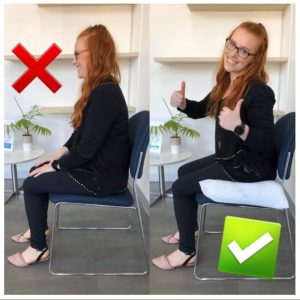Tips to relieve hip & knee pain if your elective Surgery has been postponed?
In preparation for battling the coronavirus in Australia, elective surgeries have been postponed, leaving many people suffering from knee and hip pain wondering, “When am I going to get relief from my pain?”.
Fortunately there is hope, not only to reduce your symptoms in the short term, but to really make a big difference to the pain you experience on a daily basis. In fact, if you follow these tips you may even avoid surgery all together.
[NEED TO SEE A PHYSIOTHERAPIST TO RELIEVE YOUR KNEE OR HIP PAIN? BOOK HERE]
So COVID-19 ruined your plans for that knee or hip surgery, and now you have to get on with life in this weird time, without any guarantee that your pain will get better anytime soon.
Going up and down stairs might be a painful task, and that isolation D.I.Y. home improvement project your planning is going to be a nightmare because kneeling hurts. Or maybe you can’t join your wife or husband on their walk everyday because you can’t go 15 minutes without your hip aching.
We get it, because we see it all the time in our patients. We get that you no longer feel like yourself, can’t do the things that you used to do so easily, and you feel like you’re letting you loved ones down.
We also know that surgery doesn’t have to be your only choice! Science points us to the benefits of exercise and Physiotherapy to relieve pain, improve function and prevent many surgical procedures. In fact, patients often tell us how surprised they are when they realise that they no longer need surgery, because their pain has gone after completing an exercise program tailored to their specific needs.
Even if you still need surgery, we find that symptoms such as pain and stiffness, as well as the use of pain medications can often be reduced significantly, while function improved to allow people to live more full lives whilst on the elective surgery waitlist.
So, what can you do?
Below are some simple tips you can start, to get relief from your pain.
1. Massage yourself
Massaging your own muscles regularly can significantly reduce both knee and hip pain. Not only that, it’s really easy to do.
Get in a comfortable chair so that your leg muscles can relax. Grab yourself some massage cream or regular lotion, and slowly knead the front and sides of your thigh. Make sure to target any areas that may be particularly sore and tight.
The muscles of the thigh, the quadriceps, iliaotibial band (ITB) and adductors are most prone to becoming tight in the presence of both hip and knee pain. Which is why massaging to release these muscles, will have the biggest impact on reducing your pain.
2. Use Heat packs
Heat is great, not only because it feels nice, but it can temporarily relax and increase the elasticity of the muscles. You can place the heat pack over the knee or hips for joint relief. Or you can use a heat pack to warm up the muscles of the thigh, to relieve tension on the hip or knee joints.
Combine the heat pack with the massage for more effective relief.
3. Change your sitting position
Sitting in the one position not only stiffens the knee and hip joints making you feel like a tin man when you try to stand up again, but sitting more often leads to further deconditioning and weakening of the leg muscles.
Avoid this by sitting for short periods only (less than 30 minutes), but also look at the position you sit in.
For those suffering from knee pain, ensure that your knees aren’t bent too far for prolonged periods of time, and keep them moving while you’re sitting and before you stand up.
If you’re suffering from hip pain, make sure your sitting high enough and avoid crossing your legs.
4. Pace your Activities
If you break up your physical activity into smaller chunks, you’ll find that you’ll be able to do a fair bit more, with less severe pain.
For example –
How to pace your Walking when you suffer from hip or knee pain
If you can only tolerate 20 minutes of walking at a time, then walk 15 minutes, have a rest on a bench, then another 15 minutes and repeat.
How to pace your Gardening when you suffer from hip or knee pain
If you can get an hour of gardening done before you can’t do anymore, try breaking it up into 20 minute bursts broken up by a short rest, walk or stretch before getting back into it for another 20 minutes.
5. Taping & Bracing
Taping the knee-cap can help offload your sore joint by controlling its direction of movement and thereby reducing the stress placed on this joint.
Knee braces can also provide comfort and support, and often times a very simple brace will do. However, give us a call if you’d like us to order an appropriate brace for you.
Follow these tips and not only will the pain severity you feel in your hip and knee reduce, but you’ll start to feel in control of your life again.
For a more permanent solution for your knee and hip pain, the scientific evidence points to exercise as the best way to reduce your pain and improve your quality of life.
However, we know and understand from the feedback from our patients, that exercise can be the scariest thing to start. Not only because it’s so hard to get motivated and to know where to start, but because it often hurts! And sometimes pain is a good thing, and sometimes it’s definitely not a good thing.
That’s why it’s so important to consult with a Physiotherapist, not only to get advice on the best place to start, but to also get reassurance that you’re doing the right thing. And that exercise isn’t going to make your knee or hip pain worse.
CHECK OUT THIS BLOG TO LEARN HOW EXERCISE CAN RELIEVE KNEE ARTHRITIS PAIN
If you’d like help to reduce your pain or to start exercising BOOK AN APPOINTMENT with one of our Physiotherapists.
In the current climate of COPVID-19, we’re also offering ONLINE Physio Consults.


